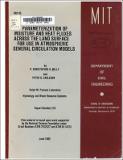| dc.contributor.author | Milly, P. Christopher D. | en_US |
| dc.contributor.author | Eagleson, Peter S. | en_US |
| dc.date.accessioned | 2022-06-13T13:09:46Z | |
| dc.date.available | 2022-06-13T13:09:46Z | |
| dc.date.issued | 1982-06 | |
| dc.identifier | 279 | |
| dc.identifier.uri | https://hdl.handle.net/1721.1/143014 | |
| dc.description | This material is based upon work supported by the National Science Foundation Under Grant Numbers ATM-7812327 ATM-8114723 | en_US |
| dc.description.abstract | The response of a bare soil surface to atmospheric forcing -- rain, wind, sunshine, etc. -- may be expressed in terms of the resultant evaporation rate and sensible and radiant heat losses. Examining the earth-atmosphere interface in an idealized one-dimensional framework, we evaluate a hierarchy of mathematical models in terms of their ability to predict this land surface response. The evaluation is based on simulation, using typical climatologic and soil parameters. The reference model, against which the other models are tested, is based on a numerical solution of a very detailed description of heat and moisture movement in porous media. The alternative models are, to a greater or less extent, simpler both conceptually and computationally than the reference model. They include the following: 1. A family of models obtained by introducing various sinplifying assumptions in the reference model. These corcern the roles of water vapor, of soil moisture retention hysteresis, and of a few other minor effects. 2. A set of models constructed by linking the forcerestore method of soil temperature prediction to each of three soil moisture parameterizations -- a two-node finite element model, a conceptualization used by climate modelers, and a nonlinear diffusion model. Using the nominal soil and climatologic parameters, we determine the critical physical mechanisms affecting the surface fluxes of water and heat. We find that an isothermal moisture equation, with the hydraulic conductivity augmented by a vapor conductivity, and accounting for hysteresis, is sufficient. The nonlinear diffusion parameterization, which includes these effects, is extended to account for redistribution. In conjunction with the force-restore method, it successfully predicts evaporation under various climatic and soil conditions. | en_US |
| dc.publisher | Cambridge, Mass. : Ralph M. Parsons Laboratory, Hydrology and Water Resources Systems , Dept. of Civil Engineering, School of Engineering, Massachusetts Institute of Technology | |
| dc.relation.ispartofseries | R (Massachusetts Institute of Technology. Department of Civil Engineering) ; 82-35. | |
| dc.relation.ispartofseries | Report (Ralph M. Parsons Laboratory for Water Resources and Hydrodynamics) ; 279. | |
| dc.title | Parameterization of Moisture and Heat Fluxes Across the Land Surface for Use in Atmospheric General Circulation Models | en_US |
| dc.identifier.oclc | 9572269 | |
| dc.identifier.aleph | 241839 | |
